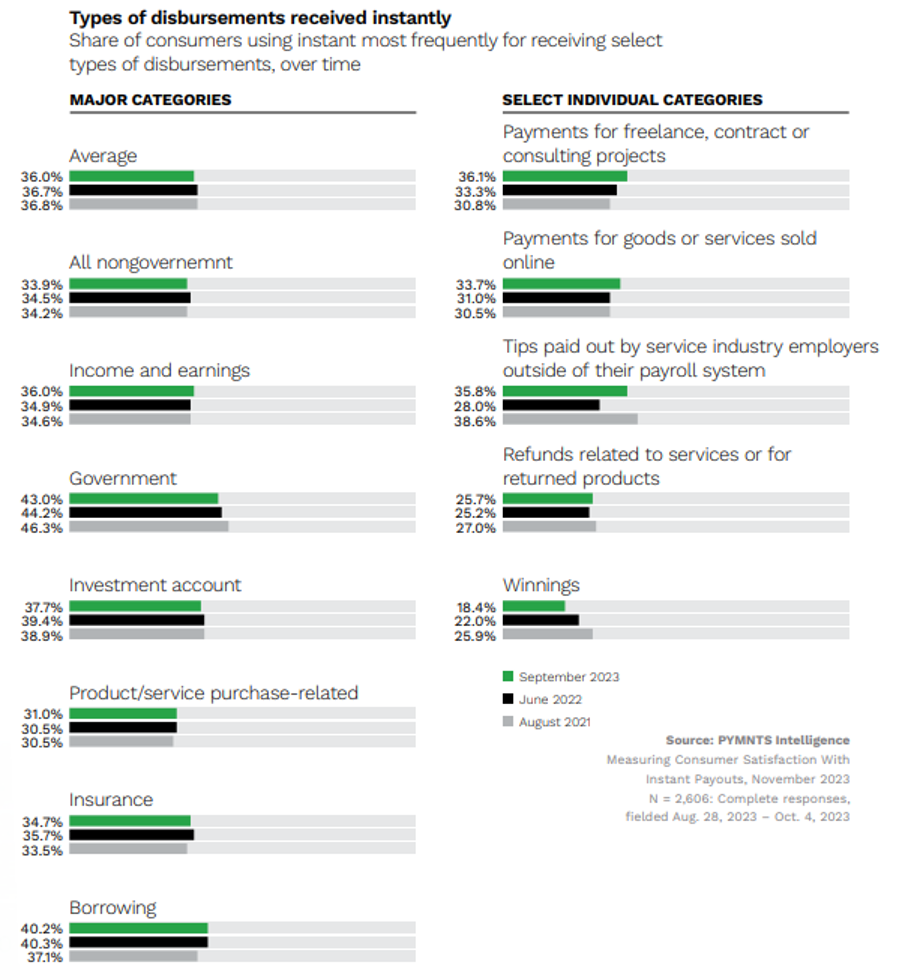Consumers Prefer Instant Payments, Federal Reserve and PYMNTS Data Show

An official with the Atlanta Federal Reserve says findings from a 2023 Federal Reserve study confirm the growing appetite for instant payments.
Claire Greene, payments risk expert with the Federal Reserve Bank of Atlanta, shared her analysis of a variety of data points that were included in last year’s “Survey of Household Economics and Decision Making.” Taken together, she wrote in a Feb. 5 blog post, the data verifies consumers are embracing faster payment whenever possible.
Exhibit A, she said, concerns cryptocurrencies. One-fifth of crypto-using respondents said the ability to “send money faster” was the number one reason they adopted digital currencies.
A 27% bump in same-day ACH payments last year is additional evidence in the case for faster payments, Greene said, as is the steep decline — 47% in 2019 to 31% in 2022 — in the use of checks and money orders. She also cited a separate Fed survey from 2022 where 75% of consumers said they were using faster payment rails such as PayPal, Square Cash and others.
For Greene, these stats help make an ironclad case that consumers prefer instant payments.
“Even households without bank accounts moved away from paper ways to presumably faster digital methods,” she wrote.
For regular readers of PYMNTS Intelligence, Greene’s verdict may not come as news. Last November, we released “Measuring Consumer Satisfaction With Instant Payouts,” a collaborative study conducted by PYMNTS Intelligence and Ingo Payments that examined the magnitude of cash distributions in the U.S. consumers and confirmed most consumers are opting instant payments in droves.
 The November study — which surveyed more than 3,900 consumers across the U.S. — found that, when given the opportunity to receive instant payments, 72% of respondents say “yes.” Sixty-two percent, meanwhile, said they would opt for instant payments if given the chance.
The November study — which surveyed more than 3,900 consumers across the U.S. — found that, when given the opportunity to receive instant payments, 72% of respondents say “yes.” Sixty-two percent, meanwhile, said they would opt for instant payments if given the chance.
We note these preferences aren’t limited to wages. In addition to earnings, the study considered other income streams including Social Security payments, tax refunds, insurance claim payouts, freelance revenue, loan disbursements and others. Six out of 10 U.S. consumers receive some form of corporate and government payments, which, on average, amounts to $34,000 annually.
And while the majority of payees confirm a preference for instant payments, some segments are embracing them faster than others. Thirty-six percent of those who earn freelance and consulting income, for instance, prefer instant payments — a 16% bump from two years ago.
But it’s not just payees who see the value in faster payments. Payers — those who distribute funds — recognize it as well. “Measuring Consumer Satisfaction With Instant Payouts” found the number of consumer disbursements was decreasing. When the report was compiled, consumers had received, on average, nine disbursements — down from 14 disbursements a year earlier. This decrease suggests payers are consolidating payments to lessen their frequency, likely due to the inefficiencies in legacy distribution methods.
The study also found customer satisfaction increases significantly with instant payments — something both payers and payees can benefit from.
The availability of instant payments leaves consumers 11% more satisfied and if the instant payments are offered for free it nearly doubles their likelihood they will remain as clients (even though many said they are willing to pay for the convenience). The study also found 78% of consumers report being “highly satisfied” when receiving disbursements via instant payments.
But even the 78% figure may not fully reflect the public’s enthusiasm for instant payments. In a separate PYMNTS Intelligence study from last year, “How Open Banking Can Provide Fast and Easy Consumer Payouts,” conducted in conjunction with Trustly, the number of consumers who said they were “very or extremely satisfied” when they received their funds in or near real time climbed to 92%.
